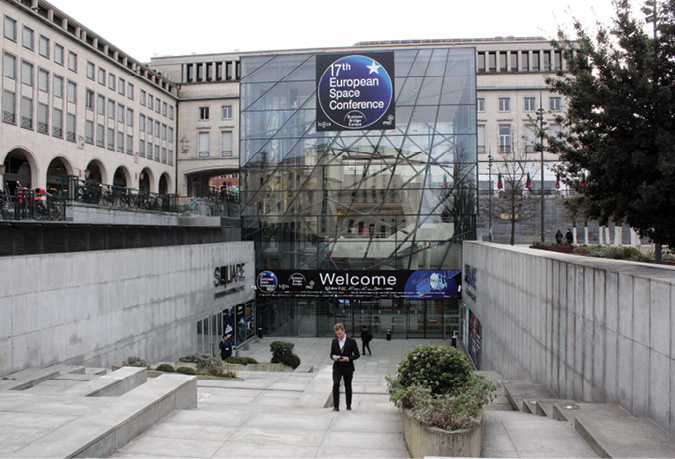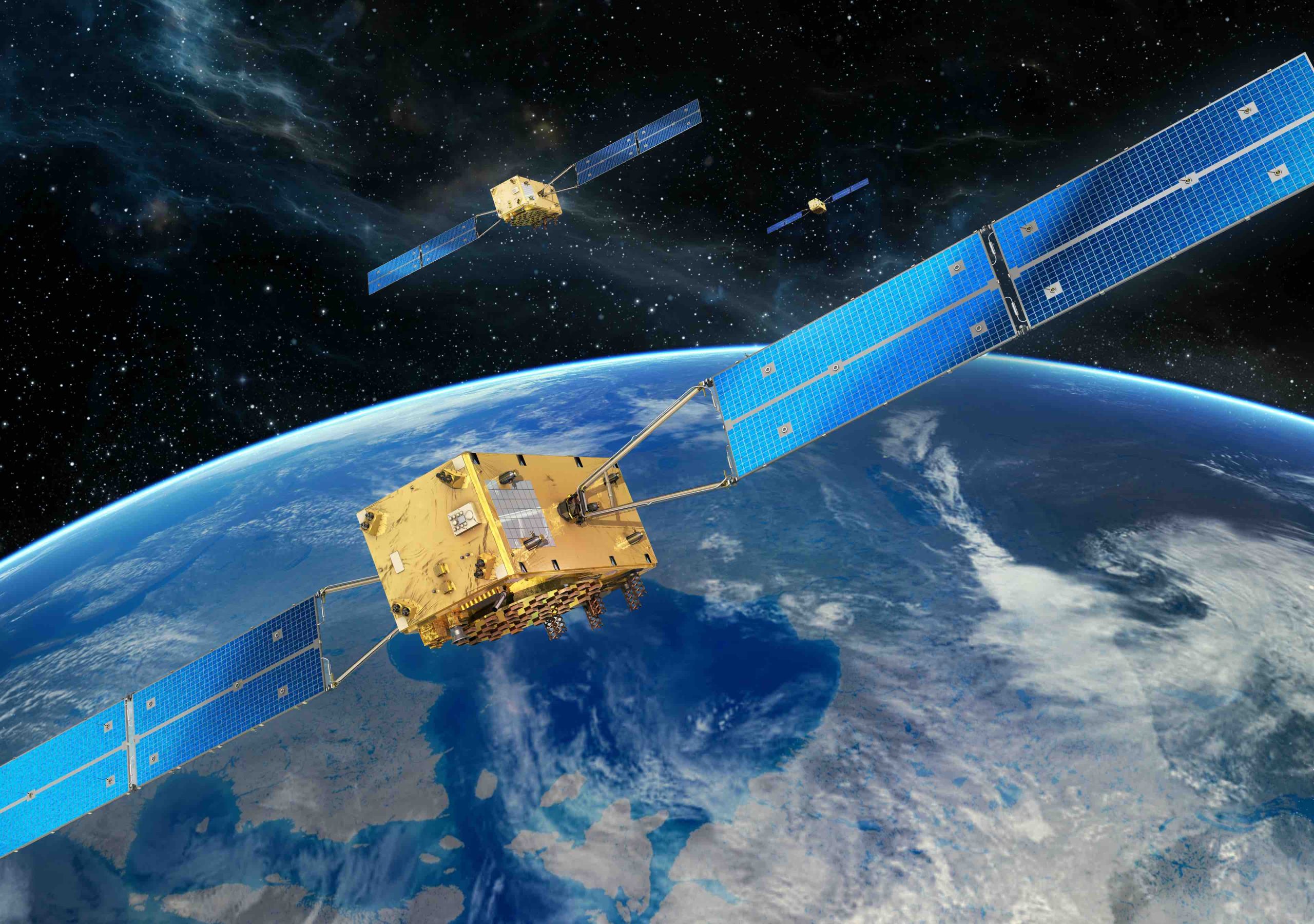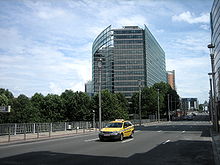Against a rapidly changing geopolitical backdrop, security and defense, competitiveness and resilience, and new innovations like LEO PNT dominated talks at this year’s conference in Brussels.
This will be the first full year of President Ursula von der Leyen’s second European Commission (EC). Speaking at the 17th European Space Conference in Brussels, EC Director for Satellite Navigation and Earth Observation Christoph Kautz talked about what the reassembled assembly could mean for EU space: “The new Commission just began its term on 1 December 2024, and, looking at von der Leyen’s program, the main overarching elements appear to be competitiveness and resilience, and of course these two aspects will be reflected in all the programs of the EU. Our GNSS flagships, Galileo and EGNOS, will not be exceptions.”
Competitiveness and resilience notwithstanding, the topics of security and defense seemed to cause the greater stir, playing front and center throughout the European Space Conference. It’s been a recurring refrain for several years now, certainly since the most recent invasion of Ukraine by Russia. Now, we see combined the ongoing horror on Europe’s eastern border with the accession of a new yet strangely familiar, and, for some, almost equally horrifying U.S. administration to the west, and Europe finds itself sorely pressed to answer the call—if not to war itself, at least to proper self-defense.
The general sense in the hallowed halls of Europe, judging, admittedly, only by the general sense in the hallowed halls of The Square in Brussels, seems to be that Europe needs to start pulling its own weight, all the while accepting it has not been pulling its own weight. And this is not to please the not exactly new man in the White House, but because it really does need to start pulling its own weight. America will not go on paying the bulk of Europe’s defense expenses, according to our sources, EU and other. Things are going to change, so we are told.

New Man in Brussels
The new EU Commission includes, appropriately, the first ever Commissioner for Defense and Space, Andrius Kubilius, from Lithuania. His portfolio, as named, brings together two domains that are now clearly seen in the highest European echelons as inextricably linked. Most of the members of the European space community heard Kubilius speak for the first time at this year’s European Space Conference, and they were not, to all appearances, disappointed.
First came the good news. The launcher crisis is over. “Europe is back.” Kubilius said. “With the success of Ariane 6 last summer, we have regained our autonomous access to space. This century belongs to space and Europe can be a leader in that domain, but we are still at a difficult crossroads.” Then he told a story.
Four months before the conference, in a distant country, Kubilius had stood with a baby in his arms, looking into its eyes and contemplating the world of the future. The baby was his newborn grandson, his first grandson. The man studied the boy and said to himself, “This baby will see the end of the 21st century.” Then he thought back to his own childhood, growing up in Soviet-occupied Lithuania, and he remembered the inspiration, the exhilaration he had felt when, as a 12-year-old boy, he watched the Americans plant their flag on the Moon.
“It was a great achievement for mankind,” Kubilius told the thoroughly diverted crowd. “It was a culmination, the end of a romantic dream. Ends are important, but practical things are also important.” Back on Earth, Kubilius listed some of the practical things being achieved by Europe in space today. To name just one, he said, “We’re still on top when it comes to navigation. Galileo is used in 2.5 billion mobile phones.
“But this is only the beginning. We are at the dawn of a new space revolution. It will bring super-fast satellite internet, super-fast navigation and observation, a booming low Earth orbit [LEO] economy, tourism in space, artificial intelligence, energy, in-space manufacturing, mining, colonies. In 10 years’ time the global space economy could triple in size.” We understand that’s a conservative estimate.
Then came the meat. “But we cannot leave space to the axis of aggressive authoritarians,” he said. “I’m not just the commissioner for space. I’m also the commissioner for defense. We need a strong European presence in space to defend Europe. We have that European presence, and while we use it to defend ourselves, we must defend it too, against any aggressor. In five years’ time, Russia could be ready for a confrontation with NATO. We must use space to provide intelligence, geolocalization and communication for our armed forces.”

From One Capital to Another
As it does every year, the European Space Conference in Brussels came directly on the heels of the European Space Agency (ESA) Director General’s press briefing in Paris. ESA Director General Joseph Aschbacher spoke in both cities, laying out some of the successes of the previous year and some plans for the new one.
“In 2024, we reached a new record in terms of deliverables to taxpayers, with 13 launches of new ESA satellites, including four Galileo satellites. We had the inaugural flight of Ariane 6, which was a huge success, and we had the return to flight of Vega-C later in the year. With that, we are now out of the launcher crisis.”
January of 2025 saw Slovenia join ESA as its 23rd Member State. The agency’s total budget for 2025 will be 7.7 billion euros, about 22% of that coming from the EU. About 12.5% of the total ESA budget, about 957 million euros, will go to navigation. Today in the U.S., funding for the U.S. Space Force, almost $30 billion, is greater than the NASA budget, which stands at about $25 billion. “So, the defense sector has very largely increased its funding share in the United States,” Aschbacher said. “ESA is at about one third of the NASA budget, and we are very happy with the deliverables we provide for the amount of funding.”
ESA’s plans for 2025 include the launch of the HydroGNSS project, one of the so-called Scout projects, wherein smaller and less costly satellites are used in important scientific studies. Work also will continue on lunar projects, including Moonlight, now in its design phase, and Lunar Pathfinder, nearing the end of its assembly and testing phase. Both of these include developments for lunar navigation.

Creating a Better PNT System
“The Galileo program is proceeding extremely well,” Aschbacher said. “The positioning signal is the most accurate in the world, and we will keep improving our technologies and expanding our activities.” The Galileo public regulated service (PRS) will reach initial operational capability in quarter three or quarter four, and the Galileo emergency warning service will also become operational in quarter four.
And of course the first LEO PNT demonstration is also planned for this year. LEO PNT is now arguably the most interesting of the concrete
initiatives on the European space-based navigation horizon. Francisco-Javier Benedicto Ruiz, ESA director of navigation said, “We are very much discussing in Europe the opportunities of low Earth orbit PNT. We are preparing for the launch of the first in-orbit LEO PNT demonstration satellite at the end of 2025. This is a new technology, a result of the progress we have made in the industrialization of mega constellations. It is really a competitive business case, with the potential to improve resilience, but also to augment the coming services of Galileo and EGNOS.”
ESA’s LEO PNT initiative started two years ago with two contracts for in-orbit demonstrators. The project will eventually count 10 satellites, to confirm, ESA hopes, the potential of low Earth orbit PNT. “Our vision is that PNT will move into a multi-layer combination of systems,” Benedicto said, “with satellites in geostationary orbit [GEO], medium Earth orbit [MEO], but also low Earth orbit.” According to the plan, there will be an operational LEO PNT capability in the 2030-plus time frame.
Marco Folino is CEO and managing officer of Spaceopal, the main contractor for Galileo operational services. About the future of European PNT, he said, “The navigation model will be a system of systems, and in this respect the integration of LEO PNT in the Galileo framework will provide a more resilient, robust and precise service. It will improve coverage, especially in urban canyons, reduce convergence time and probably lead to many new services. The important thing from our point of view as a service operator is that everything should operate and all services be delivered to the user in a seamless way.”
A consensus seems to have formed around a system of systems model. GMV General Manager of Satellite Navigation Systems Miguel Romay said, “We notice today what happens in the MEO orbits, for example with Galileo; where the satellites are very good and the lifetime is very long. Satellites that were designed at the beginning of the century last many years, so basically we end up with satellites flying in 2030 that were designed in 2000. But in this technological world that’s an enormous amount of time. So, the advantage of LEO PNT is that it can be the dynamic component. You can do things faster. If you need to implement new services, you can do it because the lifetime of the satellite is shorter and it is cheaper. In four, five years, you can deploy new services or capabilities that for MEO satellites might take 10 or 15 years and would be much more costly.”
Autonomy, Security and Defense
The yearning for an autonomous Europe, both in space and in defense, goes back for decades. Yet, for one reason or another, Europe has not managed to achieve said autonomy, in either. The extent to which Europe has depended on the U.S. for its defense has been, some would say, distastefully highlighted in recent times, as if it had ever been a secret. Meanwhile, the paralyzing loss of Soyuz launch services when the EU broke relations with Russia over Ukraine made Europe’s perplexing dependence on that country a near scandal.
Now, once again, Europe is sounding the autonomy alarm, and, as ever, it makes sense. “Galileo was built with the objective to have an autonomous European navigation system,” Kautz said. “Of course, you can never be completely alone. There are always some materials, some technologies and even services that you might have to get somewhere else, outside of Europe.”
Kautz listed a number of ongoing, cooperative and very fruitful agreements with non-European parties, including Japan and the U.S. “So, autonomous doesn’t mean that we don’t speak to others, that we have no relations with others. With the United States we have very strong cooperation, with an international agreement in place for many years on GPS and Galileo. So, it is essential that we work together with others. However, I would say, and it’s no secret, our best cooperation is with the, how should I say this, the Western World. To be clear, at least for the time being, we have no cooperation with Russia.”
Autonomy and resilience are closely linked to safety and security, meaning making sure you have what you need to survive and thrive. Part of resilience is about making EU constellations and services as relevant as possible for security and defense users, Kautz said. “When we make our system resilient, those users will come to us. So we have the Galileo PRS, where we will soon be rolling out the initial operational capability and later on full operational capability.”
Resilience also means cyber security, where the EU is investing a lot of money and effort.
“We need to work harder when it comes to the question of radio frequency interference,” Kautz said, “spoofing and jamming, especially on the eastern border.”
“Security is now huge,” said Silvio Sandrone, vice president of navigation programs at Airbus Defense and Space. “Just to give an example, in EGNOS V3, the security requirements make up one-third of all system requirements. With these modern assets, security is not something that you add on top. It’s embedded in the system. EGNOS is real-time safety-of-life. So, cyber security is not a luxury. Another way to raise resilience, which is the ability to resist threats, is to have a diverse system, and this is where we can talk about things like LEO PNT.”
Again, thoughts return to the Americans. What is the impact, if only on one’s psyche, of a returning President Trump, with his joltingly contentious team around him? Not everyone, it would seem, is losing their cool. “Of course we are very carefully and very closely interacting with our colleagues and friends in the United States,” Aschbacher said. “It’s not for me to comment on other countries’ political orientations. What I can say is that we are certainly prepared for any scenarios that might come to the table, and, more than that, we are in very close exchange every signal day with our colleagues at NASA in particular.”
On the subject of NASA, a relative outsider has been put forward as its new head. “Mr. [Jared] Isaacman has been nominated by the American president,” Aschbacher said. “As soon as that process has been finalized, I will of course be happy to sit down with him. And, for that matter, whatever government will be elected in Germany, I look forward to engaging with them and working with them too, as quickly as possible. ESA and Europe will be ready to adjust, to find its own priorities, which are certainly linked to increasing our strength, our autonomy and our capacities in space.”
As for Elon Musk, who’s been described as aggressive toward Europe, among other things, Aschbacher said, “I’m not commenting on Mr. Musk himself, but we see SpaceX as a partner, to launch spacecraft as and if needed, and we see it purely from that perspective.”
Who Our Friends Are
It’s been said you can’t always tell who your true friends are. One man at the European Space conference had no problem answering that question. “Certainly our best friends in Galileo and EGNOS are the users, because they are the ones who have been indicating to us the path to follow. Yes, PNT is the No. 1 space application in the world, but it’s the No. 1 by far, and the users are the ones who have made that happen. They know what they want, and they have told us.
“They wanted a widely available high-accuracy service, and so we now have the widely available Galileo high-accuracy service [HAS], the first worldwide, free, high-accuracy service coming directly through the signal in space. They told us they needed to be sure the signals they were receiving were really coming from Galileo satellites, and so we now have the Galileo authentication service [OSNMA], almost ready for service provision. This relationship will certainly continue. We will make sure of that, as we continue on, looking forward to more solutions and future technologies such as LEO PNT.” And with that we can sit back and relax. Fingers crossed, but confident, all at the same time.






